You have put a tonne of time and hard work to grow your email list, and create a fantastic email campaign with a strong subject line. Still, most of your subscribers may not see your emails.
At that point, you may face low delivery rates, which are the most critical challenges that email marketers face. There are so many factors that affect your deliverability. Spam email traps are one of the most significant factors.
Spam email traps create the most questions and concerns in email marketing. To help with that, we should take an in-depth look on a Spam trap.
What are Spam Email Traps?
Spam email traps are email addresses that are created not for communication but to find a spammer. This type of email addresses looks like a real email address.
These email addresses are used by the major internet service providers (ISPs) and blacklist providers to identify the actual spammer so that they can block their emails.
They create an email address that is not shared with anyone to identify a spammer. Spam email traps address can’t opt-in to receive emails. If a spam email traps receives any emails, then they consider them as a spammer.
If it has trapped your email, it will spoil your IP reputation and ruin your deliverability, and probabilities are there that they may blacklist you also. So, securing yourself against them requires a couple of cautious actions.
“A spam trap is like to be a rat catcher, show cheese and mouse gets caught.”
Type of Spam Traps?
These are the most popular types of spam traps that will impact the success of your email marketing campaign.
1. Pristine Trap
A pristine spam traps is more dangerous. These traps are not visible in site but it is present in background code so that a bot can capture that and get caught. Anyone who sends an email to this email address will be considered as a spammer. Generally, they found this kind of email address from scrapping some websites or buying an email list from someone.
If you follow poor list building practices such as buying lists and scraping sites, there are chances you might fall into this trap.
To avoid this: Don’t buy an email list. Try to build your email list, always verify your email list through bulk email verification service.
2. Recycled Trap
When an email address is not used for a long time, that will deactivate by ISP service after a certain time. Here is certain information regarding ISP service, which allowed an inactive period:
Outlook.com 270 days, Gmail 270 days, yahoo 180 days (plus extra 60 days for every year you have been a customer), and for AOL, they are allowing 90 days only.
Recycle traps are email addresses that were once valid but have been reassigned for trapping spam. These are an ancient email address that is no longer used by the real owner.
These traps are not that bad as pristine traps, but it will still cause damage to your sender reputation.
To avoid this: Get re-engagement with your customers by sending them newsletters or do email marketing campaigns regularly. Always monitor your open rate. If you notice your emails are being bounced to them, unsubscribe them immediately.
3. Email Typos
In other cases, if a person accidentally misspells their address like “outlok@” instead of “outlook@”, “gmial@” instead of “gmail@” can also be used as a spam trap. These all are unintentional mistakes of a person but can still lead to a spam email trap.
To avoid this: Before sending emails to the users, please check your write-up. If you find any spelling mistakes, then re-correct it at the same time.
Spam Traps: Oww! – Why Should you care?
Not a single email marketers want to be accused by the spam email trap. Suppose, you have sent an email to the spam trap, and you are not aware of it. It can significantly impact your ability to get your emails into the inbox of your subscribers.
If you’re sending emails to a spam traps, it indicates that you have a terrible practice to collect email addresses, or you didn’t keep your email list clean. You need to be careful about spam email traps, if you can’t, you can end up with blacklisted.
It also impacts on sender reputation. A subscriber’s email service may not deliver the sender’s emails to their inbox if they have a bad sender reputation.
Sender reputation determines by the various factors like Open rates, Spam complaints, Unsubscribe rates, Opt-in rates, and Hard bounce.The total proportion of spam email traps in mail traffic as per the recent quarterly graph by Securelist in 2019, is the largest share of the spam trap was recorded in May (58.71%), August (57.78%), or in April (57.21%). The average rate of spam in global mail traffic was 56.33%, down 1.38 p.p. against the previous reporting period.
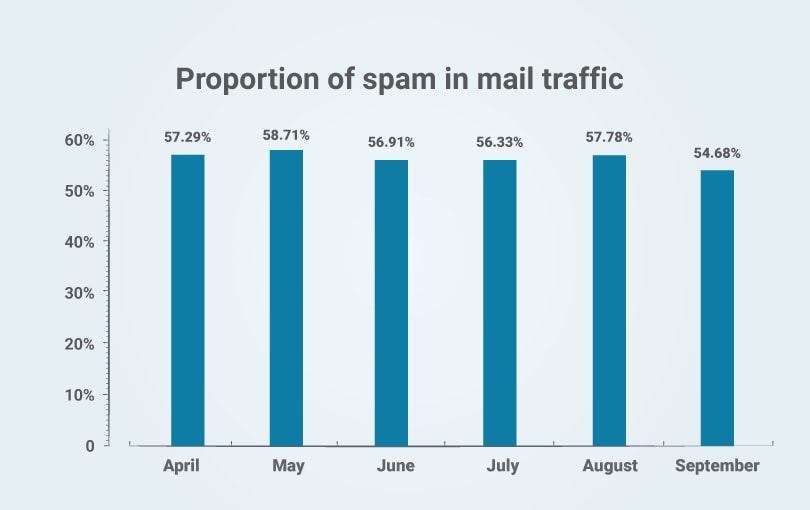
Is there a Spam traps is on my list?
Firstly, you have to check your IP, and your domain has been blocked or not! For that, you have to use an Email blacklist check with the help of mxtoolbox. If your IP or domain is blacklisted, then likely you have a spam email trap on your list.
You need to monitor your delivery rates regularly to make sure that your list isn’t affected by a spam email trap. If your delivery rates decrease steadily, then you may have a spam email trap on your email list.
Damage caused by the Spam Email traps!
Here are the damage caused by the Spam email trap:
- Sender reputation will be damage
- IP addresses may be added into a blacklist
- Your domain could be permanently added to a blacklist.
How do I fix the problem?
With the help of the Email Verification Service, you can detect valid, invalid email addresses and also certain types of a spam email trap. This is where email hygiene comes from.
The best tips on how to avoid spam email traps:
Here is the list of the most important, actionable tips to avoid your email meant for your customers falling into spam email traps.
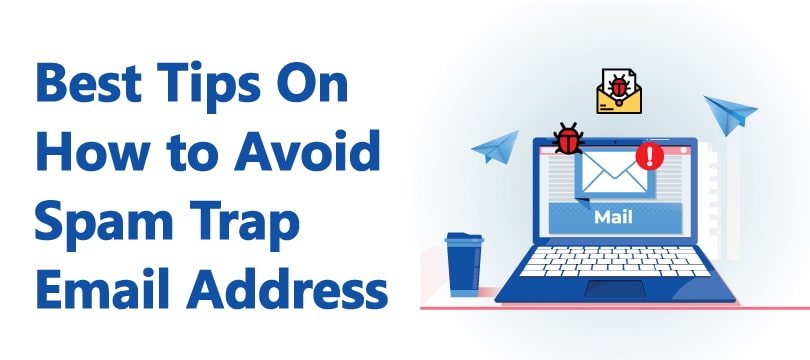
1. Email list – Never buy it!
Want to buy an email list? It is the worst thing! Legally it signifies a violation of ISP’s terms of service. Selling or transferring email addresses to others is illegal; it can owe spam act.
It also represents a violation of the privacy to those people whose addresses are on the list as they won’t accept to contact you.
Eventually, the examination from convince and convert demonstrates that email records that have 10% or more unknown user addresses tend to have 44% of their emails delivered by ISPs!
These email lists contain info that is out of date and as such, usually includes inactive or dormant addresses or recycled spam email traps.
If these lists are harvested, then chances are their — they will contain real spam email traps. A single direction pass to email marketing is hell, so avoid them!
For example, Imagine you are going to buy something, and you have paid for that, and there is no exchange offer or no return policy! When you come to the home, and you checked that there is something damaged or it’s not working properly! What happens!! the money you have spent for that goes useless, the time you have spent to buy has been wasted. You can’t even use that! Isn’t it disgusting! This is what happens if you buy an email list!
2. Do verify your email lists periodically
You need to make sure your email lists are verified and have no chance of a hard bounce. Clean email lists can help you to reduce your hard bounce rate, and you only have to send emails to those emails which exist. This is an excellent marketing practice to follow.
If you send emails to invalid addresses, then it will affect your deliverability rate. You can detect invalid email addresses from the email verification service.
3. Always maintain the frequency of Sending an email
Your subscribers will forget you if you send too few emails. On the other hand, If you send too many emails, your subscribers get irritates. So it’s better to send emails on fixed intervals and maintain that frequency.
With a regular frequency, you can spot any of your email addresses turned invalid. You can suppress those emails from your email list before they become spam email traps in the future.
For example, You have a friend list of 100. You are not connected for long, what happens! They will forget you, but if you do messages or call in some interval of time, you will be connected with them for a lifetime.
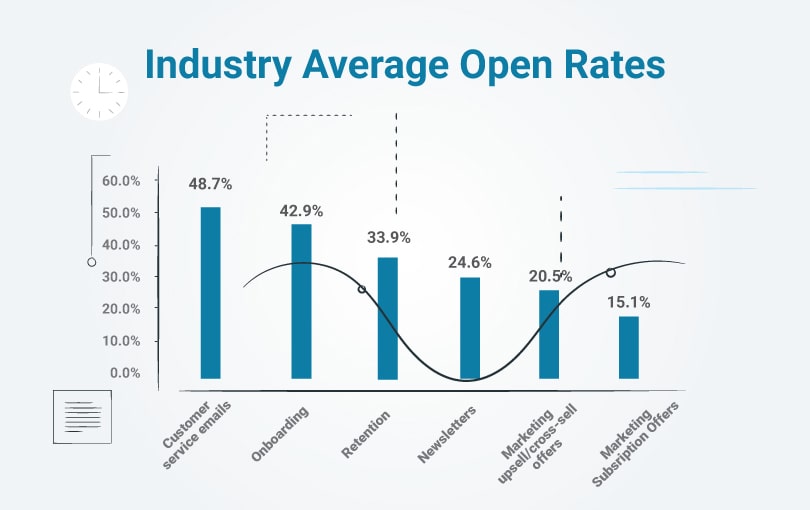
As per the above Industry average, open rates graph by vbout, Customer service emails are 48.70%, Onboarding users are of 42.90%, and retention users are 33.90%, For newsletter 24.60%, Marketing upsell/ cross-sell offers are of 20.50%, and Marketing Subscription offers users are only 15.10%.
4. Keep an eye on open rates and click rates
Only sending emails is not a complete process in email marketing campaigns. After sending emails you need to consider the open rates and click rates of that campaign to understand the user’s engagement factor.
If people don’t open your emails, not interested in your emails, then why should you send emails!!
Inform them they can continue being on your email list by opting again. If users don’t opt-in, then you should remove them from your email list.
5. Use a double opt-in
If you are building an email list of new subscribers, how will you verify that recipients want to receive email from your brand? Almost everyone recommends using a double opt-in method. Which provides a subscriber, and must confirm before officially end up on your email list.
Having subscribers utilize double opt-in demonstrates that they have an authentic enthusiasm for your emails which will keep your commitment and deliverability rates high.
For Example, You are running an e-commerce store and want to engage with your visitors, who do not buy any product. You may offer them a lucrative discount if they share their email address. Once they provide consent and register their email. You send a confirmation mail to their email address. The moment they click confirmation mail they become a double-opt-in subscriber.
6. Do authenticate your email with SPF, DKIM, and DMARC
Here are some methods to authenticate your email and prove to the inbox providers that email is worthy of the inbox or to a spam folder:
- Sender Policy Framework (SPF) – Ensures the authenticity of your mail server’s IP address with a list of IPs authorized to send from that domain.
- Domain Keys Identified Mail (DKIM) – DKIM allows analyzing that an email claimed to have come from a domain was indeed authorized by the owner of that domain. DKIM assures that the email has not tampered during the transmission.
Domain-Based Message Authentication Reporting and Conformance (DMARC) – It is an email authentication protocol. DMARC makes it easier for both the sender and receiver server to determine whether the email is legit or not and what to do if the email is not legit.
Here is the ratio given in graphical representation of how email is authenticated:

As per the graphical representation by Google Security blog, 2.6% of emails are unauthenticated, 1.7% are DKIM only, 9.8% are of SPF only and to include both DKIM and SPF both represent as 85.9%.
7. Avoid blacklists and monitor your IP reputation
Every email domain has a reputation associated with it, and if it slips or sends an email to a spam email trap, you may find yourself in an email blacklist. Unluckily, even cautious senders may find themselves on a blacklist.
Using a real-time email address verification, you can find an invalid or wrong email address. By monitoring your delivery rates will advise you of any sign that you might be on a blacklist.
Overall Tips:
- Get your email list clean regularly with email verifiers
- Always monitor your IP reputation, Open rates, and Click rates
- Never buy an email list
- Re-engage with users who haven’t open your emails in the last 6-12 months
- If they are not interested in your product or service remove them from your list.
- By this, you can save your time and money
Final Word
There is no definitive guide for the assistance you manage the email deliverability issues and no equation to ensure your emails won’t appear in spam. No matter how hard you try!
The above tips, your email campaign performance receives the best results. Here’s a famous email marketing quote by Bob Frady:
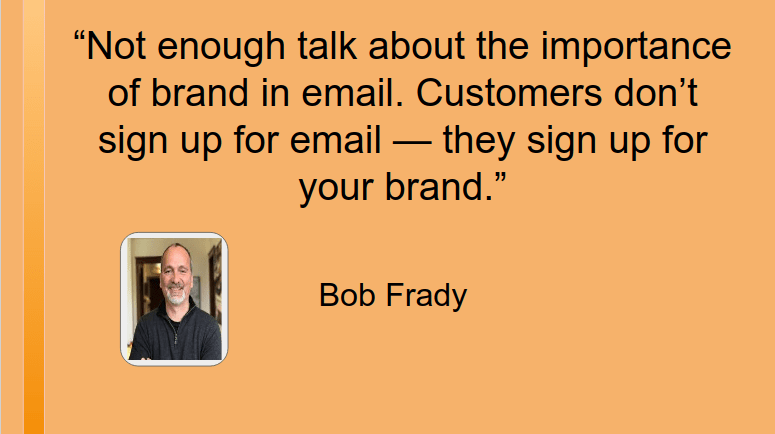
Have you ever faced ending up in a spam email trap? We would love to hear about your experience. Please comment below.
FAQs on Email Spam
How to stop receiving spam emails?
To stop receiving spam email you can label them as spam in your mail app. erase them. keep your email under wraps. You could also try out a specialized spam blocker. get a new email ID. or cancel subscriptions to promotional materials.
What are spam emails?
Spam emails are a real headache. These messages you didn’t ask for sometimes pack risky links or scams. To kick spam to the curb, tag it as such then trash it. throw up some filters while you’re at it.
How to avoid emails going to spam?
Want your emails to stay out of the spam folder? Start by creating real connections with your audience. Choose subject lines that are obvious and related to what’s inside. Finetune your email message, make sure your domain is authentic, steer clear of words that set off spam alarms, keep a tidy list of contacts, stick to the rules for email marketing that work best and keep an eye on whether your emails are getting through. Stick with these tips, and you’ll see better results from your emails.
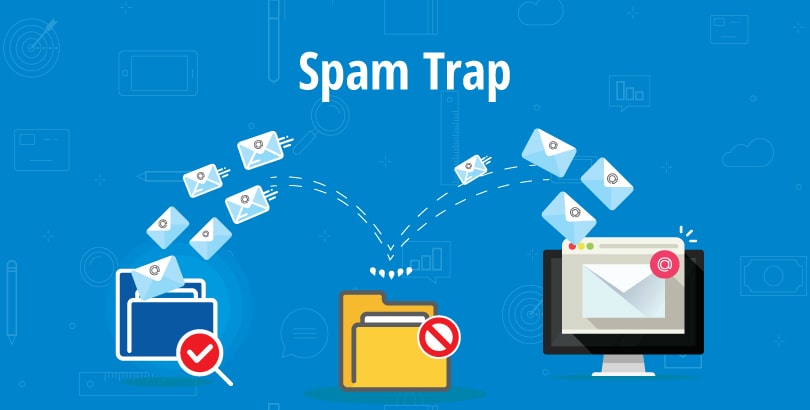
Thanks! For tremendous and detailed content 🙂
I was looking for spam-traps information, and finally, i found it here, this information is indeed educational, and cleared my all doubts about spam-traps, keep up the great work looking forward to your next post.
Hi, I found your article on spam traps amazing. I am starting an email validation and verification service, and I am wondering if you might be interested in consulting with me or if you could suggest others that might be able to help set up this service!
Thanks,
Awesome post and tips, thanks for sharing
Hey,
Thanks for the detailed article, Can you help me with..
How does a spam trap end up in my email list?
Hey Shira,
The main way a spam trap can wind up in your rundown is on the off chance that you don’t pursue email marketing best practices. Along these lines, abstain from buying email lists, occasionally evacuate unengaged subscribers, and utilise an email validation service to eliminate bounces.